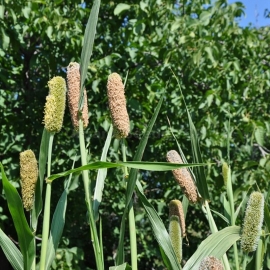


Organic Tunisian Sorghum Seeds (Sorghum)
1.14 €
Excellent grain-type sorghum, originally collected in a market in Tunis, Morocco. Smallish, brown to almost olive-colored grains are ground for use as porridge in their native land.
-
Organic Tunisian Sorghum / Sorghum
Excellent grain-type sorghum, originally collected in a market in Tunis, Morocco. Smallish, brown to almost olive-colored grains are ground for use as porridge in their native land.
Slender stalks and narrow leaves might be an adaptation to their native land. Compact seed heads occasionally cause lodging, so plant a bit deep. Needs really warm temperatures to thrive; recommended for dry-summer areas.
Health Benefits of Sorghum
Digestive Health: It seems like many healthy foods contain some amount of dietary fiber, which greatly improves the functionality of the digestive system.
Cancer Prevention: The bran layer of the sorghum grains contain important antioxidants that are not found in many other types of food.
Diabetes Control: Excessive carbohydrates break down into simple sugars.
Bone Health: Magnesium is found in high quantities in sorghum.
Energy Levels: Niacin, also known as vitamin B6, is a key component in transforming food.
